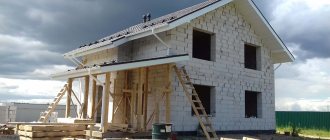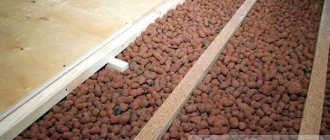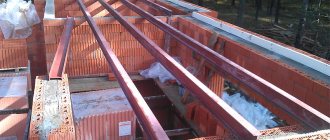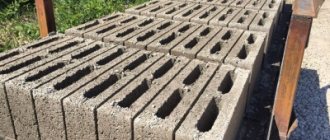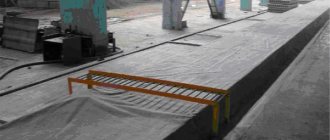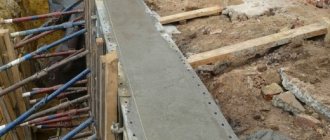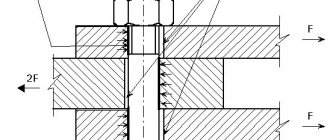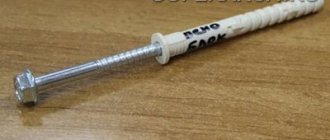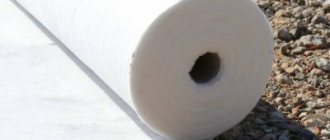Insulating a garage is a process that worries many owners of this small building today. Everyone began to understand that a car lasts much longer in a warm room. Therefore, in this article we will talk about insulation methods, how to insulate a garage from the inside and outside, and what aspects of the insulation process should be paid attention to first.
Insulated garage from the inside, lined with OSB slabs Source roomester.ru
What is the best way to insulate: outside or inside?
According to all construction canons, the best option is insulation from the outside. The thing is that the boundary between the thermal insulation material and the sheathing is the zone where condensation forms. And if you do insulation from the inside, then this zone falls between the insulation and the walls of the garage. At the same time, the latter freeze completely (through and through) in winter, which negatively affects the building material itself. Plus, condensation, which reduces the performance characteristics of any building material.
This is the first reason. The second is the ability not to reduce useful space in the garage. Insulation installed on walls takes up some space. Here you will have to add the thickness of the skin. That is, on each side of the walls there will be a reduction of approximately 3-5 cm.
The third reason makes it possible not to pay attention to the environmental friendliness of the thermal insulation material. It will be located on the outside, street side, which means that if the insulation releases substances harmful to humans, they will immediately evaporate. Moreover, such materials are much cheaper than environmentally friendly ones.
Insulation of the garage from the outside Source remstroiblog.ru
But it is not always possible to insulate the garage walls from the outside. If for some reason this cannot be done, then all thermal insulation work is moved inside.
Requirements for protecting a garage from low temperature
Garages are primarily built from cinder block, brick, and sometimes ironwork. The thickness of walls made of cinder block or brick is most often in the range of 120-250 mm. They practically do not protect the room from low temperatures, so for comfortable work they need to be reliably insulated.
When insulating a garage internally, you do not need to seal all the holes - this will not improve thermal insulation, but may cause certain problems . Without constant ventilation, moisture from the air will condense on the metal and it will begin to rust. Ventilation also prevents harmful gases from accumulating in the garage.
Overview of the thermal insulation materials market
Before moving on to the process of insulating a garage structure, let’s talk about insulation materials. About those that are used today for this purpose. There is a fairly large layer of building materials of this type that builders use today. There are traditional materials here, and others that have appeared recently, but have already gained popularity.
Mineral wool
This insulation has been used in construction for a long time. At the very beginning of its appearance, it was a roll-type material. Today it is still produced in this design, but the modern form of mineral wool is slabs. They are called mineral wool slabs.
It should be noted that a fairly wide range of materials is used as raw material in mineral wool slabs. But basalt-based insulation is very popular. This thermal insulation material is presented on the market in slabs of different densities and thicknesses. This makes it easier to select according to the required characteristics.
Mineral wool boards are a popular insulation material Source 2gis.kz
The only drawback of mineral wool is its hygroscopicity. That is, this material absorbs moisture well, while losing its thermal characteristics. To prevent this from happening, the heat-insulating layer is covered with waterproofing films on both sides. Today, manufacturers offer moisture-resistant mineral wool slabs, in which hygroscopicity is reduced to the maximum. This makes it possible to refuse waterproofing.
Will not talk about all the technical characteristics of mineral wool. Let us designate the most significant one, according to which you need to choose insulation. This is the thermal conductivity of the material.
On a note! Thermal conductivity is the property of a material or body to transfer heat. The lower this parameter, the better in terms of insulation.
So for mineral wool this characteristic is 0.035-0.04 W/m K.
Expanded polystyrene boards
Many people call this material foam plastic, which is fundamentally wrong, although both materials are included in the group of foamed plastics made from polystyrene. It’s just polystyrene foam – a material originally created for packaging. It has low density and low thermal insulation qualities. The same cannot be said about expanded polystyrene, which was originally developed as a thermal insulation material.
Moisture-resistant polystyrene foam boards Source www.stroyportal.ru
See also: Catalog of popular plots in the Moscow region for the construction of a country house
This foam insulation has serious advantages:
- thermal conductivity – 0.028-0.034 W/m K;
- the extruded version does not absorb moisture ;
- passes air through itself;
- strength – 1 kg/cm²;
- inert to many chemicals;
- mold and fungi do not live on the surface of the insulation
- it is a good sound insulator ;
- service life – 30 years.
But polystyrene foam boards also have their drawbacks. And the most important of them is fire hazard. The insulation burns well and maintains combustion, while emitting acrid smoke. Today, manufacturers are trying to change the situation with this indicator. Fire-resistant boards have already appeared on the market, but there are not many of them.
And one more point that you need to pay attention to when choosing expanded polystyrene as insulation. This is the brand of material. The optimal option for a garage is PSB-S-35 (40) - self-extinguishing, with a density of 40 kg/m³. The thickness of the slabs should not be less than 50 mm.
Expanded polystyrene boards brand PSB-S-35 Source karkasdomproekt.ru
Polyurethane foam
This is a two-component material, the ingredients of which are mixed before application. In terms of its physical state, it is a foamed semi-liquid mass that hardens in air, forming a hydrophobic layer on the insulated surface. That is, not afraid of moisture.
Application of polyurethane foam requires special equipment. It is applied under pressure from a hose with a nozzle. The high adhesive characteristics of the material give it the ability to adhere to any surfaces that are previously cleaned of dirt and rust. In this case, the mixture fills all the cracks, gaps and holes.
This is a non-flammable insulation. Service life – 50 years. Thermal conductivity – 0.019-0.028 W/m K. moisture absorption is minimal – 1.2%.
Layer of applied polyurethane foam Source foamshop.ru
See also: Catalog of companies that specialize in the construction of small architectural forms
Warm plaster
This plaster solution got its name because manufacturers add particles of heat-insulating material to its composition. These can be polystyrene foam granules, so-called crumbs, vermiculite (foamed rock of volcanic origin), sawdust and other ingredients.
In fact, such a plaster mixture has higher thermal insulation characteristics than conventional plaster. But to achieve a good effect, the material must be applied in a sufficiently thick layer. It is used both for insulating the garage from the inside and for thermal insulation from the outside. It is understandable if the garage is built from bricks, blocks or concrete slabs. For a metal structure this option is unacceptable.
Warm plaster is applied to the wall in a thick layer Source tk101.ru
So, we have looked at the main thermal insulation materials that are most often used today when insulating a garage building. Of course, this is not the entire list of proposed options. They just use these more often.
Most often, many consumers are looking for how to insulate a garage from the inside inexpensively. The table provides a comparison of prices for the described insulation materials.
| Insulation | Mineral wool boards | Expanded polystyrene boards | Polyurethane foam | Warm plaster |
| Price | 13-20 rub. for 1 m² | 15-50 rub. for 1 m² | 1200-1500 rub. for 1 m² | 350-750 rub. for 1 m² |
The price range for each material is quite wide. This is explained by the fact that the basis for pricing is the thickness of the insulation and its density. The table shows that the most inexpensive option is mineral wool and polystyrene foam boards.
The most economical thermal insulation materials Source krysha-expert.ru
Choice of insulation
Choosing the best material for insulating a garage is a responsible matter. There are many materials for insulation: sawdust, mineral wool, glass wool, polystyrene foam and others.
You can choose any option you like, but this article will look at insulation using foam plastic as an example (except for the floor). It does not allow moisture to pass through, gives the room good thermal insulation, does not rot, is easy to install and has an affordable price.
Of course, there are also disadvantages, including poor breathability and flammability. But you can purchase special foam treated with fire retardant. Such expanded polystyrene stops burning immediately after the source of fire is eliminated.
Insulation technologies
Having dealt with the question of how to insulate a garage, we move directly to the process itself. Let's start with external insulation. The simplest option is plastering. Everything is quite simple here. Warm plaster is applied to the external surfaces of the garage walls using standard technology. That is, they throw it onto the surface with a trowel and level it with the rule according to the installed beacons.
There is an option for mechanized plaster. To do this, special stations are used in which the plaster mixture is prepared and then immediately applied to the walls under pressure. In this way, insulation can also be carried out from the inside of the room.
Primary requirements
Insulation of the garage should be carried out taking into account the following requirements:
- Do not block the ventilation openings.
- Measures aimed at protecting against heat loss should involve the use of special materials not only on the walls, but also on the roof and floor of the room.
- Garage doors must close hermetically, and for reliable protection against the penetration of cold, the metal surface of these elements should be covered with heat-insulating materials.
Important! Before you begin insulating a private garage from the inside with your own hands, it would be useful to study SNiP 2.07.01 - 89. The sixth section of this document outlines the basic rules for vehicle storage premises.
Video description
In order not to go into details of the technological process, we suggest watching a video that explains how to properly apply warm plaster to walls in two ways:
Expanded polystyrene boards for external insulation
If the garage is built from bricks or blocks, then polystyrene foam boards can simply be attached to the wall surfaces, laying them tightly together. There are two mounting methods:
- on mushroom-shaped screws or, more precisely, on dowel-nails for insulating materials;
- on the adhesive composition.
Usually the first one is used, because glue for polystyrene foam is an expensive thing. It is sold in cans. The contents are applied to the back of the slab in the corners and in the middle. And then they just press him to the wall.
As for self-tapping screws, these are special plastic fasteners consisting of two parts: a dowel and a nail. Under the first one, a hole is made through the insulation in the wall into which the dowel is inserted. At the same time, its wide cap will hold the insulating board. After which the second part is hammered into it, which bursts open the first.
Dowel nail for insulation boards Source de.decorexpro.com
Typically, two fasteners are used for each slab. When laying thermal insulation, it is very important to ensure that there are no gaps or cracks between its elements. It is optimal to use slabs with a tongue-and-groove connection for this purpose. If ordinary slabs with smooth edges are used, then when gaps form between them, the latter are filled with special foam. It is similar to the assembly one, only it does not expand in volume when exposed to air.
How polystyrene foam boards are attached to the wall with mushroom-shaped nails Source stroyfora.ru
Air exchange rates
According to SNiP 21-02-99 “Car Parking”, a warm garage must be equipped with supply and exhaust ventilation, and in such a room the air temperature must be maintained no higher than 5°C.
Ventilation in the garage is needed to:
- dry the room intensively;
- dilute and remove exhaust gases;
- dry the car.
ABOK standard “Residential and public buildings. Air exchange standards" requires at least 180 cubic meters of fresh air per hour per passenger car.
Foreign manufacturers of ventilation equipment (XPELAIR, UK) believe that a garage should provide 6-10-fold air exchange: for a garage with a volume of 60 m3 - from 360 to 600 m3/h.
MatildaFORUMHOUSE Consultant
No one in their home adheres to these standards, but it is necessary to ventilate at least 0.5 - 1 volume per hour, otherwise the machine will begin to rust.
Insulation of the floor and ceiling in the garage
The floor is easiest. This is a thick concrete screed, under which you just need to lay insulation. Expanded clay is most often used for this. They do it like this:
- At the site where the garage is installed, a pit is dug up to 50 cm deep.
- Crushed stone is poured into it in a layer of 15 cm.
- Then sand in a layer of 15 cm with compaction.
- Cover with roofing felt in two perpendicular layers.
- Expanded clay is poured.
- Another waterproofing layer .
- A reinforcing grid of steel reinforcement is laid.
- Pouring concrete.
You don’t have to fill in expanded clay, but use expanded clay concrete mortar instead of concrete. Instead of expanded clay, you can fill in perlite or lay polystyrene foam boards.
Layers of insulated garage floor Source mirstrojka.ru
As for the insulation of the ceiling, everything will depend on what this building element of the garage structure is.
- If it is a concrete floor slab , then it is better to assemble a suspended structure into which insulation is placed. You can use warm plaster.
- If it is a metal roof , then it is optimal to treat it with polyurethane foam.
- Since the roof of a metal garage is assembled, like the walls, in the form of a frame sheathed on the outside with iron, slab insulation . The technology is the same as on the walls.
Conclusion
Of course, looking at various photos of a high-quality insulated garage, everyone wants to reproduce such a decent finish in their own home. And this is quite real, there is nothing complicated about it.
Any “straight-handed” person is able to do everything himself without much expense or effort. It won’t take too much time, but there will be a huge amount of benefits. The car will be protected from the influence of an aggressive external environment, and its owner will be able to comfortably carry out car repairs during the cold season.
Sources
- https://garazhov.ru/inside/uteplenie-garazha-penoplastom.html
- https://pechiexpert.ru/uteplenie-garazha-penoplastom-01/
- https://www.tproekt.com/kak-uteplit-garazh-iznutri/
- https://www.plast.by/novosti/utepleniye-garazha.html
- https://garazhmechti.ru/kommunikacii/kak-uteplit-garazh-iznutri-deshevo.html
- https://mirstrojka.ru/uteplenie-garazha/
- https://uteplenieplus.ru/kak-uteplit/garazh/kirpichniy-garazh-iznutri/
- https://bibiauto.club/sovets/poleznoe/uteplenie-garazha-iznutri.html
- https://garazhmechty.ru/kak-pravilno-uteplit-garazh.html
- https://www.ivd.ru/dizajn-i-dekor/zagorodnyj-dom/vse-o-samostoyatelnom-uteplenii-garazha-iznutri-56901
[collapse]
How to prevent cold bridges from appearing in garage doors
Many garage owners are well aware of the signs of spring “walking” at the base of the gate, which prevents them from closing normally. This structural element is in direct contact with the environment.
Protecting the poles from freezing will help eliminate the problem. If the garage already has standard iron gates, they require internal insulation.
Before starting work, you need to prepare the surface of the gate. Inspection for corrosion is carried out. If there is damage, it is removed with a wire brush. To eliminate cold bridges, the existing grooves are sealed with polyurethane foam. After the surface has dried, waterproofing treatment is carried out with 2 mm thick isolon or bitumen mastic.
One option is to fix heat-insulating sheets with dowels to metal sheets. If it is impossible to use this method, adhesive compositions are used. After installing the material, a vapor barrier film is placed on top, and then the outer cladding is used. To increase the thermal insulation effect, foil-coated polyethylene is recommended.
Proper selection of insulation and strict adherence to installation technology allows you to solve the issue of thermal insulation of the garage on your own, without resorting to outside help.
Mineral wool
Available in the form of slabs and rolls. It retains heat well and has sound insulation properties. But at the same time, it easily absorbs moisture - high humidity is the main enemy of cotton insulation. And when wet, it completely loses its ability to insulate heat. Therefore, its use requires high-quality hydro- and vapor barrier. It is almost impossible to dry this insulation; it becomes brittle and easily damaged. And when the glass wool gets wet during installation, it clumps and becomes unsuitable for further use (cavities appear inside it).
Considering that the external insulation pie can be damaged or depressurized, using this material is risky. In general, mineral wool is not the best choice for vertical installation. It has considerable weight and consists of fibers. Under their own weight, they can sag over the years, and voids will begin to form between them - the so-called cold bridges.
This heat insulator has two advantages: low price and equally low thermal conductivity. But that's all. Then only the shortcomings begin. Once in the lungs, glass particles are no longer excreted from the body. They leave itching and irritation on the skin. When installing them, a protective suit, a respirator and a mask are required, and after completion of work, a thorough cleaning of the room is required. Then you will have to wait a day or two until the glass dust, invisible to the eye, settles.
If during operation there is at least partial damage to the protective layer of films or foil material, you will again need to rent special clothing and resort to cleaning after completion of the repair.
And finally, the material shrinks and is not durable. Therefore, it does not matter what type of insulation you prefer: internal or external, it is better not to stop at this option.
Styrofoam
This material is very popular due to its low cost and ease of installation. It retains heat well and lasts for decades. You can install it yourself, without having any special tools or special construction skills at hand. But it still cannot be called an ideal solution. Although not as significant as mineral wool, it absorbs moisture. Very easily damaged and crumbles. Its granules have low adhesive strength, so over the years they can fly out even with accidental pressure on the material.
But that’s not even the main thing. There is a huge amount of uncertified polystyrene foam in the market due to the high demand for it. Finding a high-quality and safe product for health is not an easy task. And the one that was produced in violation of technology, when the temperature rises and the sun’s rays hit it, it begins to release toxic substances. Considering that the garage is a closed space, this is fraught with serious health problems for the car owner.
Outdoor installation
With this approach, all layers of insulation and waterproofing are located on the outside of the ceiling. Accordingly, it is necessary to create a heat-saving “pie” that can withstand all temperature and climate changes. There are two main types of flat roofs, insulated differently:
A classic roof is insulated according to a standard scheme and the layers are laid in the following order, counting from bottom to top:
- Floor slab
- Vapor barrier film
- Insulation
- Waterproofing
This scheme has a significant drawback - external waterproofing requires periodic maintenance and repair. It is produced every two to three years and this entails additional costs, although such a roofing device is slightly cheaper than the other option - the inversion one.
This type of roofing is considered more expensive to install, but it withstands temperature changes better and does not require such frequent repairs. Its fundamental difference from the classic version will be a different scheme for laying layers and arrangement:
- The first will be, as in the previous case, the floor slab
- Then - screed
- Next comes waterproofing
- Next is insulation
- A special film is placed on top - a filter.
- Cover the pie with expanded clay or gravel, at least 50 millimeters thick
This solution allows you to protect the waterproofing gasket and significantly increase its service life.
Expert advice on how to insulate a garage roof
A warm garage is one of the main factors determining the good “health” of a car. One cannot but agree with this, because the cause of condensation is sudden temperature changes. And condensation is the number one enemy of metal anti-corrosion protection and, naturally, can cause significant harm to the car. But how to insulate a garage roof, what material will be “warmer”?
The roof is the main component in the system of protecting any structure from adverse weather conditions. Therefore, it is not enough just to insulate it; it needs constant prevention from leakage, dampness, and other things. How to properly insulate a garage roof so that it performs its functions best. There is no need to “discover America”, as for any type of structure there are already specially developed building codes and regulations that indicate the optimal conditions for maintaining machines.
https://youtube.com/watch?v=NrbYylCqtLQ
Required Tools
Each stage of garage insulation work requires its own set of tools. The list also depends on the selected material, but mainly the changes will affect cutting devices. For example, mineral wool can be cut well with a construction knife, but polystyrene foam is easier to handle with a homemade “hacksaw” made of steel wire on wooden handles. You can, of course, use a jigsaw, but in this case the sheets will crumble a lot, so you will have to work slowly. The rest of the set of tools is standard.
To prepare surfaces:
- a hard synthetic brush (in some cases - a hand brush or a cord brush for an angle grinder);
- grinder - to remove protruding reinforcement and large protrusions of the main surface;
- narrow spatulas for sealing cracks.
To attach the insulation:
- drill/screwdriver;
- construction stapler;
- notched trowel or mounting gun for adhesives.
In the case when the insulation layer is laid in the sheathing, do not forget to select a tool for making the frame: a jigsaw for a wooden beam, a hacksaw, an angle grinder or scissors for a metal profile.
How to insulate a concrete roof of a garage or house
Externally, you can use polystyrene foam and mineral wool slabs of increased rigidity, for example, Tekhnoruf from the well-known company TechnoNIKOL. External insulation of a concrete roof is preferable when the ceiling has been finished inside the room and additional costs will be required for dismantling and installing the finishing. In addition, high-quality waterproofing of the insulation will be required, since it will be exposed to moisture all year round.
Photo. Scheme for laying mineral wool slabs on a flat roof
If waterproofing is properly installed on the outside, then work can be done from the inside. In this case, you can use cheaper mineral wool with a lower density, as well as foam boards. Please note that carrying out work inside is accompanied by a loss of some ceiling height in the room. And mineral wool needs to be additionally protected with a vapor barrier membrane from moisture contained in the air.
Sequence of work
The construction of a garage is carried out in a certain sequence:
- construction project, calculation of materials and marking of the territory;
- foundation installation;
- walling;
- roof installation;
- installation of window and door openings;
- gate installation;
- insulation, waterproofing;
- final protective and decorative finish.
Let's look at all the stages in more detail.

